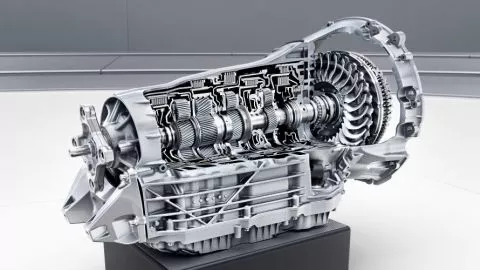Automatic or manual transmission: advantages and disadvantages - Grupo Concesur
Contenido del artículo
The transmission of a car is one of the most important parts of the propulsion system. It is responsible for connecting the engine with the wheels, sending the movement directly to the drive axle or axles. At Mercedes Benz we work to develop state-of-the-art gearboxes, designed to improve both comfort and performance, especially in Mercedes AMG models. But what are the differences between an automatic and a manual gearbox?
The set of gears that make up an automatic or manual transmission is responsible for converting the motion generated by the engine into propulsion on the drive wheels. Our automatic gearboxes are fuel efficient, improve driving comfort and increase the performance and acceleration of our models. For this reason, Mercedes Benz has extensive experience in the development of automatic gearboxes.
Mercedes automatic transmission: what types are there?

In order to optimize the performance and efficiency of our model range, engineers are constantly working on the development of new engines and gearboxes. At Mercedes Benz, we are committed to the development of automatic transmissions and offer a wide range of transmissions available depending on the model. There are currently three types of Mercedes automatic transmissions:
7G-DCT automatic transmission
It is a seven-speed dual-clutch automatic transmission, available together with the gasoline engines of the Mercedes Benz compact range (A-Class, CLA, B-Class...), which combines speed and efficiency.
8G-DCT automatic transmission
This new automatic gearbox is an evolution of the 7G-DCT transmission. In this case it has eight speeds and a dual clutch system. It is available with the diesel engines of the compact model class.
9G-TRONIC automatic gearbox
This robust automatic transmission with torque converter offers nine speeds and high driving comfort. This automatic gearbox is available in the range of Mercedes Benz sedans and SUVs.

In addition to the automatic transmissions mentioned above, there are other types of gearboxes dedicated to specific models. For example, the Mercedes AMG range is equipped with reinforced automatic gearboxes designed for maximum performance at all times. Meanwhile, Mercedes electric cars are available with special gearboxes adapted to the demands and needs of a 100% electric propulsion system.
Advantages and disadvantages of automatic transmission
The Mercedes automatic transmission is designed to improve fuel consumption, enhance performance and raise driving comfort to the brand's highest quality standards. An automatic transmission offers a number of important advantages.
Advantages of automatic transmission
- Greater everyday comfort. With no clutch pedal, you don't have to worry about shifting, downshifting or selecting the gear that best suits your driving style and speed.
- Ease of driving. No need to clutch or disengage to change gears.
- The number of gears of an automatic car is defined by the manufacturer, but do not worry, the system is totally independent, and the transmission itself is responsible for choosing the best gear at all times so that you only have to worry about enjoying the trip.
- It offers safer driving by not having to take your hands off the steering wheel to change gears.
- A significant improvement in fuel consumption and emissions. Sailing mode is only available with this type of gearbox.
- You get better performance, especially in acceleration, than with a traditional manual transmission. You can also control gear changes using the paddle shifters located behind the steering wheel.

Disadvantages of automatic transmission
- It requires some time to adapt, especially if you have never driven an automatic car.
- An automatic transmission needs regular maintenance, although in a car with a manual transmission, the gearbox also needs maintenance. An automatic transmission tuned and serviced regularly at Mercedes A or B maintenance will be as reliable and durable as a manual transmission.
Manual gearbox, advantages and disadvantages

Manual transmissions are becoming less and less common. In Mercedes Benz we have been betting for years on automatic transmissions for our cars given the significant advantages they have over a traditional transmission. Even so, we still offer some models with manual transmission in the range of compact vehicles with gasoline engines. These are the main advantages of this type of gearbox.
Advantages of the manual gearbox
- A greater sense of control over the car. Interfering directly on the gearbox connects the vehicle and the driver. However, an automatic transmission also allows you to enjoy these sensations thanks to the steering wheel paddles.
- It is more economical. That's why we offer it on entry-level models and versions. However, the Mercedes automatic transmission is not an overpriced extra in most of our cars.
- It implies less use of the brakes as the engine brake can be better utilized.

Disadvantages of the manual gearbox
- Some parts, such as the clutch, suffer increased wear and tear and can lead to failure over the kilometers.
- It is more difficult, especially for inexperienced users who are learning to drive an automatic car.
- Generates fatigue, especially in urban driving, when constantly shifting gears and downshifting.
- A car with a manual transmission offers fewer gears than an automatic transmission. Generally, a manual transmission offers six speeds, compared to the nine ratios available in the Mercedes Benz 9G-TRONIC transmission.
- The use of the manual transmission is reflected in lower acceleration and response in situations where higher performance is needed.
Discover these and other advantages of the Mercedes automatic transmission in Concesur Group. Our experts will advise you to choose a new, Km 0 or used Mercedes that best suits your needs.













